TRACCE no. 7 – by Angelo Fossati – Andrea Arcà
Tracing the Past. Petroglyph reproduction for Rupestrian Archaeology
This paper reproduces the poster for ARARA meeting May ’97.
It has also many points in common with the previous article of A. Fossati in TRACCE 6, while showing something more. It also represents a good introduction to our tracing professional workshop.
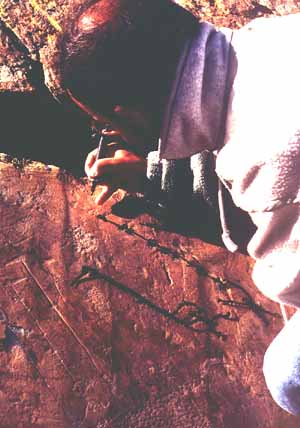
Tracing by transparence
Rupestrian Archaeology
The approach to the methodology debated in this poster is mainly the result of the experiences acquired in that particular petroglyph area that is Val Camonica (Italy) and the Alpine Range: in any case we believe that most of the points hold good for other rock art sites, despite the fact that each site may have different traits and conditions that must be carefully considered before starting any scientific work.
The term Rupestrian Archaeology was coined in Val Camonica in 1989 to indicate the need to treat the study of “rock art” as an archaeological discipline, on a par with other branches.
The archaeological point of view in petroglyph analysis is intended to be of primary importance.
It means that a petroglyph is assumed to be archaeological remains, and it must be treated exactly like other archeological remains.
There is the necessity of clarifying its chronological and cultural attributions: when it has been executed and why. We won’t speak about the methods involved in these tasks, not pertinent to the theme of this paper. We’ll treat only the section related to the most important basic data, the iconographic ones.
The presence of many different layers or phases (each one of them should be referred to a different culture) on the same rock surface is very common: the first consequence is that the more recent figures have been executed overlapping the ancient ones. So an engraved panel is often the result of many centuries (or millennia) of engraving practice. Untying the layers of superimpositions is quite similar to the study of an archaeological stratigraphy.
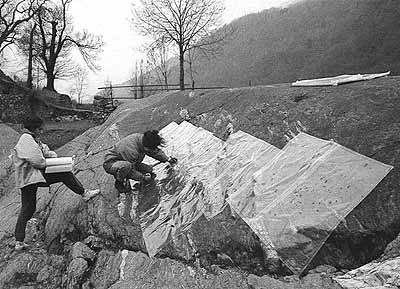
Controlling the traced sheets over rpm (Valtellina – Italy)
Why trace?
Firstly one should notice that this paper refers only to the engraved figures (petroglyphs) and not to the painted ones (pictographs), for which the tracing methods could be quite completely different. Then we must underline over the iconographic nature of the petroglyphs, which makes them in many cases similar to the decorated pottery or tools or weapons.
In the same way that we need to have a good reproduction of the scenes depicted or embossed in vases, we have the necessity of recognizing perfectly all the figures engraved on a rock surface. Perfectly means that we can’t accept any missing data, particularly in distinguishing each figure and each superimposition.
So we must achieve the best accuracy in reproducing each scene, each figure, each engraved dot. We can consider a tracing done only when all figures have been reproduced. This preliminary statement is very important.
A not complete reproduction, exactly like a digging not well conducted, has no archaeological value.
This archaeological value must be maintained in books too, where the printed tracings must show immediately any important detail (once more, figures and phases).
This doesn’t mean that the tracing should be considered as the only recording method: photography, for example, is very important, but, as for the decorations found in rusted weapons, it must be accompanied by a graphic reproduction.
Many faced engraved figures can be seen only with a particular light over the rock surface, and best recognized only after having traced them. A good tracing take many hours for each standard paper (80 x 60 cm), and many days for each engraved panel: this means that there is a lot of time for the tracer to carefully consider any figure, evaluating each particular and each superimposition.
This time, a fundamental time, is the time of the "understanding". A time not easy to obtain if not in a direct contact with the engraved surface
The investigation of a site or rock with petroglyphs involves a number of steps: some in the fields and others in the laboratory. The first thing is to note on a map the position of the carved surfaces and to compile a form with all the information regarding the rock itself, also noting the state of conservation, stippling patterns, variations in the patina etc…
Cleaning. Sometimes the rocks have most of their carved area covered by a mantle of soil and/or vegetation (e.g. moss and lichen). What to do? It is sure that this mantle obscures the petroglyphs, making impossible any correct and complete understanding of the engraved subjects. On the other hand we must consider that moss and lichen growing over the figures could, arguably, contribute some information about their date, and the same could be said for the excavation.
Even if very rarely the covering has any archaeological stratigraphy, we can imagine that, in the future, the development of the studies could bring a technology able to give more information.
So, even if it is not an ethic applied everywhere, it is probably the case of leaving in the rock art sites few rocks or part of carved rocks not studied, not cleaned, not unearthed, waiting for the future generations of rock art specialists
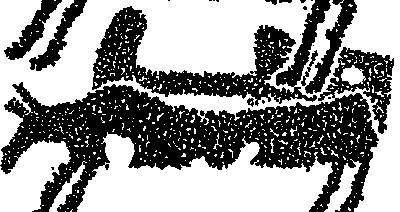
Superimpositions among the figures (Cemmo 1)
Once the visibility of the petroglyphs is assessed the next step is to trace the figures.
Plastic sheets. The easiest and best way to record a petroglyph is to use transparent plastic field sheets, commonly cut to standard sizes. Stippling and scratching figures are generally traced in black, while red is used to show cracks and natural striations. Tracing is done by transparency with the plastic sheets in direct contact with the engraved surface.
Light. The engravings are best seen in natural grazing light, but, where these conditions are impossible, the use of mirrors can help the highlighting. Also, artificial light can be useful at night, or, if it is possible, in the daytime, after covering the rock with a big black and thick plastic sheet.
Dots reproduction. While drawing a pecked figure the tracer should follow the dots of the pecking, without coloring the inside completely black.
In the case of superimposition within the engravings the last one (the more recent) should be copied first: the other, covered by this, should be traced leaving a very small piece of pecking or scratching.
The iconographic effect is normally good and in the scientific publication one can recognize the perception of the superimpositions. Another technique is to trace using different colors, but the problem is to understand the phases of the drawing before the tracing, something not easy even after the drawing has been finished.
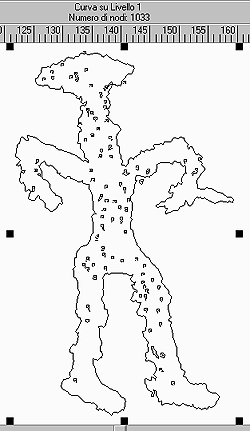
An autotraced figure (Susa Valley – Italy)
Tracing and auto-tracing
At the end of the work, each traced surface has been reproduced by various plastic sheets, organized in a grid with standard measures. As it is not possible to manage the tracing in the original (1:1) dimension, there is the need to reduce them to a suitable scale (from 1:4 to 1:32, depending from the dimensions). So each sheet is reduced by photography or photocopy, and manually joined with the others to obtain the complete surface. The best way is to do it with graphic software, scanning and autotracing the reduced sheets. Even if it’s long work, in this way there is the possibility of transforming each figure into a scaleable object, very useful when there is the need of changing colors (or in a greyscale) to underline the different engraved phases.
Rubbings and stereophotogrammetry
Other documenting techniques, such as rubbings (or frottage) are not as precise as tracing: the superimposition within the figures and the distinction between the carvings and the natural fractures are often not clear. In any case the frottage, if repeated continuously on the same figures, can be considered a destructive technique, and can cause the abrasion of the pecking.
In recent years stereo-photogrammetry has been sometimes adopted as a tracing technique (for example in Lombardy and in Veneto regions, northern Italy): unfortunately the figures were traced only with a contour (like in the drawings of the first rock art scholars!), or the inside filled in black completely, without the evidence of the peckings
Sometimes the differences between the natural cracks and the figures are not clear, as well as the superimpositions. The problem is that the drawings of the stereo-photogrammetry were not made by rock art specialists. At the moment the results that we know are very far away from the current standard of tracing requested by the scholars.
Stereo-photogrammetry can surely be used for other purposes, i.e. to understand the state of conservation (impact of the microflora or the consumption of the engravings).
Focus-point
We are working in an Alpine rock-art area with more than 100,000 engraved figures, where some 300 square meters surfaces with thousands of figures have been entirely traced and where there is the concrete possibility of comparing engraved tools and weapons with the real tools and weapons found in the archaeological diggings. So we have a continual seriation, from the ancient Copper Age (marked by the so-called remedellian-kind daggers) to the late Iron-Age (marked by the so-called halberd-axes), passing through various well-known Copper Age, Bronze Age and Iron Age spears, shields, axes, knives and swords. The correct correlation between engraved figures and real ones is demonstrated by the superimpositions.
So the most important focus-point in tracing is experience: experience in recognizing the figures and the superimpositions, experience in finding the best light, experience in adapting the recording techniques to each particular site. A tracing is not an objective reproduction of an engraved surface: only a picture should comply with this task, even if often without showing completely any engraved detail.
Part of a Cemmo1 traced sheet (Valcamonica – Italy)
A tracing is like an enhanced picture, where the filter is given by the eye and by the mind of the tracer, under a correct archaeological control. In this sense, joined with pictures and records, tracing is an essential and powerful tool in petroglyph recording.
piazzale Donatori di Sangue 1- 25040 CERVENO (Bs), Italy
tel. 39-364-433983 – fax 39-364-434351
contact page















Leave a Reply